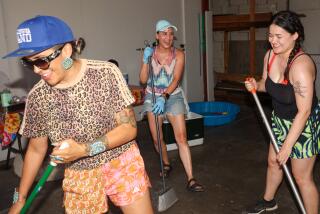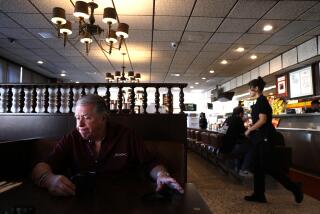With gentrification, Echo Park gang members move outside their turf
Sgt. Victor Arellano drove slowly through the hills of Echo Park, cruising by the places where he had seen the guys hanging out in the past. There was the market painted bright yellow with large green letters spelling out “BEER WINE” and the hidden staircase nearby. The graffitied stretch of pavement along Preston Avenue and the house where a known gangster lives.
A few hours into his evening shift and the LAPD gang officer still hadn’t spotted any members of the Echo Park Locos. He wasn’t surprised. It was a Wednesday.
So many gang members have been priced out of the neighborhood, he said, that their presence can be hard to spot during the week. But on Fridays and Saturdays, they make a pilgrimage back to their roots. They ride in from El Sereno, Eagle Rock, even the Inland Empire, to hang out. Each Monday, trash cans and stop signs wear fresh “ExP” graffiti.
“It becomes a weekend gang,” Arellano said.
The change came as the gang, which for decades commanded an intimidating presence in the neighborhood, saw its membership dwindle. Echo Park lost some Locos to bullets and others to prison. Another group of active gangsters chose to uproot their families from the violence. But one of the biggest changes came with gentrification.
As the new millennium settled in and boutiques and coffee shops with catchy one-word names crept farther and farther down Sunset and up Echo Park Avenue, gang members started to move away. They couldn’t keep up with rent costs. The Locos lost numbers and strength. The gang is smaller, but its weight is still felt.
Now city officials hope to further cripple its influence with an injunction that prohibits members of the Locos and five other local gangs from congregating within a newly drawn safety zone that encompasses the neighborhood. The restriction applies to gang members who live in the neighborhood and those who have moved out but sometimes return.
The injunction — a first for Echo Park — divided the neighborhood. Some residents welcomed the officials’ promise that it would mean safer streets. At a Greater Echo Park Elysian Neighborhood Council meeting two months before a judge approved the injunction in September, Los Angeles City Atty. Mike Feuer characterized it as an integral part of a broader solution.
“The gang injunction is a tool,” he said. “A tool, not the tool, in the city’s effort to try to curtail gang violence.... If folks are not hanging out as much, bad things happen less, to put it in very basic terms.”
Others think the injunction makes it too easy for police to unfairly profile Latinos.
“The cops creep by and give me a look,” said Salvador Aguirre, an Echo Park native who protested the injunction this summer. “Being bald and Mexican American, we’re all looked at the same. We’re all the problems. I don’t want to be looked at twice.”
::
An eclectic neighborhood of pretty hillside homes perched above downtown, Echo Park has a long history of counterculture and gangs.
Over the years — propelled by mentions in movies and books — Echo Park’s reputation for gang violence spread. When “Mi Vida Loca,” which was filmed in the neighborhood and featured some gang members, was released in 1994, it gave outsiders a glimpse at the violence locals already knew.
That year, a community group called the Echo Park Security Assn. hired Darin Williams’ security company to start patrolling the neighborhood. The Locos were big and brazen then. Sometimes, Williams would round a corner and see 40 guys standing in the middle of the street drinking beer. Most of them were underage, none of them cared if he saw. Gun shots were fired at least twice a week back then.
The violence waned gradually, Williams said, and it wasn’t until a community meeting held after veteran gang member Eric Zamarripa was killed in 2009 that he realized just how stark the transition was. Residents addressed Zamarripa’s family directly — which itself would have seemed crazy a decade earlier. Their message, he said, was simple: “We’re not afraid of you.”
Police see the difference too.
During the Wednesday evening shift, Arellano stopped his black-and-white outside the market that was once the gang’s home base of sorts and didn’t see any familiar faces. All he spotted was a man pushing a stroller and a woman holding a yoga mat. He shifted back into drive, zigzagged with the narrow street until it dead-ended and got out to look for graffiti. A woman walked by and he introduced himself. She smiled and shook his hand. Then she peeked over her left shoulder. Soon after she moved into her home four years ago, she learned the neighborhood truism: don’t be seen talking to the police.
Arellano nodded and reminded her that she could call anonymously. Then he asked what she thought about the injunction. Anything that helps her feel safer, she said, is worth it.
“When I want to take the garbage out at 10 o’clock at night,” she said. “I think twice.”
A few blocks away, a dark blue building wore a fresh coat of spray paint. The big E and P made a statement: Weaker, but not gone.
Alex Espinoza, 30, said the gang he joined as a teenager is almost unrecognizable now. He remembers when he could roll down almost any block in the neighborhood and pass a house or two that belonged to his homies. They were at least 100 strong back then. Now only a handful of them still live in the neighborhood. But new guys keep coming up, he says, and an injunction won’t stop that.
“There’s always going to be gangsters,” said Espinoza, who is no longer an active member but keeps in touch with some who are. “Little youngsters running around trying to make a name for themselves.”
::
At least once most weeks, Espinoza’s friend — a 31-year-old Echo Park native who asked to remain anonymous because he has connections to the gang — commutes back to his roots.
He grew up in a second-story apartment on Echo Park Avenue in the 1990s.
When he was 19, the landlord raised the rent by $20 a month. His mother refused to pay until the leaky plumbing was fixed. That never happened and they got evicted. His brother and sister moved in with friends and his mother went to a shelter. He stayed in the empty apartment alone until someone changed the locks.
Eventually, the family settled into a place in Eagle Rock. It was bigger, but he says it was too quiet. No gunshots, helicopters or sirens. So he takes every opportunity he gets to head back to Echo Park.
One weekend he drove in to watch the Mayweather-Canelo fight at his friend’s house. A couple Sundays later, the guys and their families gathered at Elysian Park for fish tacos and a chance to catch up. An old friend showed up and he gave him a handshake that turned into a hug.
“Nothing will ever feel like Echo Park did,” he said, smiling sadly. “Where you reach down and grab the dirt and you say, ‘Yeah, I’m solid. This is home.’ ”
The Locos aren’t the only weekend gang in Los Angeles, said Mike Garcia, a former gangster who now works as a gang interventionist in Boyle Heights. He has seen the trend play out in several other gangs, he said, including with his own, Primera Flats. The lures are simple: belonging and relationships.
“The cops are always saying that they come back for gang violence,” he said. “It’s not true. They come back ‘cause that’s where they feel comfortable. “
More to Read
Sign up for Essential California
The most important California stories and recommendations in your inbox every morning.
You may occasionally receive promotional content from the Los Angeles Times.











